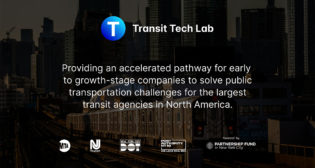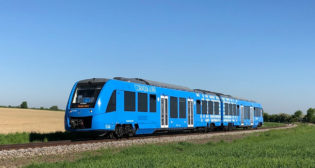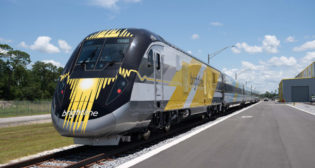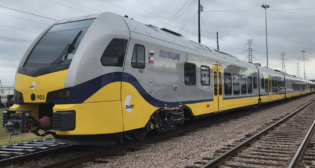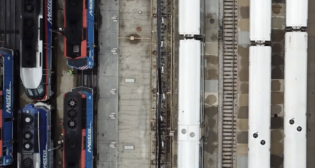
Improving Ridership Modeling and Service Development Plans Through Better Travel Data
Written by Nebraska Digital, administrator
NICTD photo by HDR.
Using new tools to forecast ridership for better passenger rail planning.
COVID-19 created a massive shift in ridership patterns, one that has not settled into its final new normal. This presents a problem for agencies who are looking to invest in capital projects: How do you forecast ridership when tomorrow won’t necessarily look like today?
At the same time, ridership modeling is a key component of accessing grant funding for rail projects through the Infrastructure Investment and Jobs Act. Both the Federal Railroad Administration and the Federal Transit Administration have indicated that ridership modeling and other types of analysis completed for a rail project’s service development plan will play a major role in advancing federally funded intercity and commuter rail projects.
Data is becoming more abundant, and the transportation industry has become more adept at using it to build, refine, calibrate and validate travel demand models. Updating or developing a defensible service development plan with good ridership data in today’s challenging environment requires a new technological solution. In conjunction with traditional ridership forecasting techniques, incorporating travel data from anonymized cellphone data into your ridership model can provide a more precise look at where and how travelers are getting from Point A to Point B. This sets a sponsoring agency on a good track to obtain federal funding, advance a project through future phases of development, and secure public support for project implementation.

The Need for Improved Ridership Modeling
Ridership on all modes of public transportation has shifted dramatically since pre-2020, and travel behavior continues to evolve. People are working more from home. The typical Monday-Friday commute—traveling in the morning to a downtown area and returning in the evening to the suburbs—is happening less. Trains are being used increasingly for other trip activities, which often precipitates travel at other times such as midday, evening and weekends.
Traditional ridership forecast models such as 4-step and activity-based models rely on U.S. Census commuting data and large expensive travel surveys. This data can tell us where people live, where they work, and their demographics. But it can’t tell us when and where people go for recreation. Also, it doesn’t tell us about the discretionary, non-work trips that are starting to make up a larger portion of rail ridership. The good news is there is new data available to fill these information gaps.

Using New Travel Data to Fill In Gaps
A variety of data vendors have broad, anonymized cellphone data that provides a fuller picture of where people are going and when. For example, city centers with high-traffic sporting events or festivals can draw crowds that wouldn’t be captured by traditional methods such as Census data. But these events and other activities draw crowds that could use a new rail corridor.
Using data sets that track cellphone locations, we not only can discern that people are attending these events, but we can also learn where they are coming from, exactly where they go, how long they stay and where they return to. This information can help justify a new transit route to serve high-use areas not located along a commuter line.
These data sets alone won’t predict the future of travel. But considering them along with traditional model inputs can create a fuller picture of future ridership demand and set a new passenger rail line on a path to success.
Avoiding New Travel Data Roadblocks

With innovative approaches come new challenges, though these can be mitigated by an experienced travel modeler.
As with any data set, it is important to vet the data. Unlike Census data, which has been reviewed and can be used off-the-shelf, new data sets must be assessed by a data expert. For example, a hurricane knocked out many cellphone towers along the East Coast several years ago. If this data were used without review, it would have appeared that fewer people were traveling in that October than in any other month.
In another example, the northbound and southbound lanes of a Boston bridge are stacked vertically rather than side by side. Our profession is improving our understanding of linking cell phone data spatially in GIS platforms. Cell phone data showed that 100,000 cars traveled north and another 100,000 traveled south daily. But because of the structure’s design, where northbound and southbound lanes were stacked, the cars were being counted twice, and in reality it was a total of 100,000 cars—about half traveling north and the other half southbound. Ensuring the accuracy of the data leads to correct assumptions and a truer understanding of the project corridor.
New Enhanced Data to Conduct Smart Outreach
This more detailed data also provides a foundation for a strong outreach plan. The data can’t replace community outreach but can help identify avenues for community outreach:
- Referencing cellular data with Census tracts can show likely language and cultural barriers. For example, if many potential riders are in a majority immigrant area, outreach can be tailored to the languages spoken there.
- Data on when trips get made can indicate good times to hold public meetings and outreach.
- Typical trips for this area can unveil new outreach avenues. For example, if many people often attend a farmers’ market, outreach can be conducted at that event.
Interactions with potential riders can paint a picture of how a new line would be used. They can also help show that the plan meets environmental justice requirements.
Importance of Service Development Plans

Service development plans are not new; these documents have long been an important step in the process of planning new or expanded passenger rail corridors, laying out the feasibility and the need for increased service. What is new is their expanded role in the process of selecting projects for funding from new and expanded programs under the IIJA, also known as the Bipartisan Infrastructure Law. Core elements of a service development plan include a Purpose and Need statement, planning and engineering analyses, evaluation of alternatives including environmental factors, identification of a rail service governance structure, and outreach to obtain input from stakeholders including agencies and the public.
Service development plans will be essential in FRA’s evaluation of intercity passenger rail projects advanced through the Corridor Identification and Development and the Federal-State Partnership for Intercity Passenger Rail Grant programs. A new IIJA requirement is a capital project inventory and the order in which federal funding will be sought. Projects will be summarized by FRA and submitted to Congress as an annual project pipeline report.
New commuter rail projects, funded through the FTA New Starts and Small Starts programs, face heavy competition for funding. In support of improved service development plans, FTA is asking agencies to conduct new passenger surveys to help understand how travel patterns have changed in the post-pandemic environment to justify the ridership and provide confidence in the results. This request underpins the need for improved travel data.
Advancing Service Development Planning to Serve New Generations
The IIJA funding gives agencies a generational opportunity to expand and advance passenger rail services. A well-crafted service development plan that incorporates the full spectrum of technical disciplines including modernized ridership forecasting, and that better reflects new travel patterns, will set a new rail line on the path for success. In decades to come, we will see these plans come to life, leading to successful rail corridor development to serve generations of passenger rail customers.
About the Authors
Scott Peterson is a senior travel demand modeler at HDR with decades of experience in providing all sorts of modeling for transportation agencies. Matt Van Hattem is a senior railway planner who specializes in rail plans including service development plans. Catherine Dobbs is a senior environmental project manager and a former FRA central team lead with a deep understanding of today’s regulatory environment for freight railroads.
